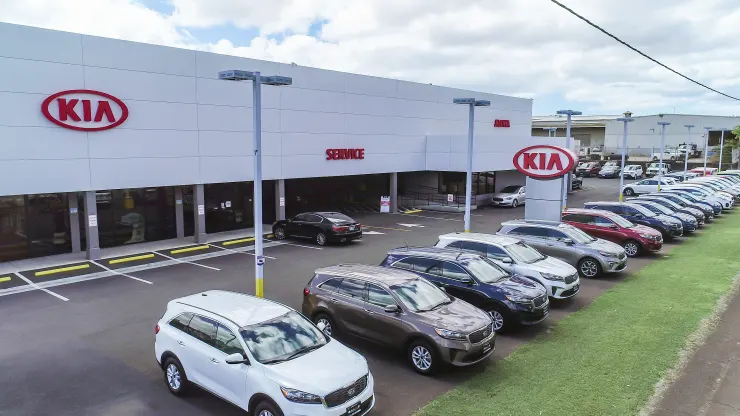
Key Points
- Despite the slower than expected adoption of all-electric vehicles by consumers in the U.S., Hawaii has emerged as a leading state in EV adoption.
- According to J.D. Power, Hawaii ranks fifth in overall EV adoption at 11.9% of new retail vehicles sold through February this year. It is the top-ranking state without specific regulations aimed at promoting EVs and reducing emissions.
- The reasons for Hawaii's high EV adoption rate include the high cost of fuel, the availability of renewable energy, and the cultural factors, as stated by Ivan Drury, director of insights at auto research firm Edmunds, who resides in Hawaii.
U.S. consumers have been transitioning to all-electric vehicles at a slower pace than anticipated, but Hawaii is emerging as a leading adopter of EVs. The tropical island state currently holds the fifth position in overall EV adoption, accounting for 11.9% of new retail vehicles sold through February, as reported by J.D. Power.
In addition, Hawaii ranks third in J.D. Power's "EV Adoption Score," trailing behind only California (46.1) and Washington (37). This score is calculated based on market dynamics, consumer preferences, EV availability, and other factors, with Hawaii scoring 33.8.
Top U.S. states for electric vehicle adoption January–February 2024
J.D. Power's index tracks EV adoption in relation to weighted sales.
The horizontal bar chart shows the overall adoption of EV vehicles in California, Washington state, Hawaii, Oregon and Colorado in 2024.
Elizabeth Krear, the vice president of the electric vehicle practice at J.D. Power, stated that adoption of electric vehicles is dependent on their availability to meet the needs of shoppers. She explained that in California, where there are more EVs available compared to Hawaii, 33% of consumers are choosing to purchase EVs when given a viable option.
J.D. Power also noted that Hawaii, despite not being part of the California Air Resources Board’s Zero-Emission Vehicle program, is the top state for EV adoption. This program promotes EVs and enforces stricter vehicle emissions and miles per gallon standards for traditional vehicles in states that have adopted the measure, including California, Washington, Oregon, and Colorado.
What is the appeal of Hawaii?
What factors are contributing to the increasing preference for electric vehicles in Hawaii? According to Ivan Drury, director of insights at auto research firm Edmunds and resident of Waikiki on Hawaii’s Oahu Island, it is a combination of high fuel costs, the availability of renewable energy for charging, and cultural values. He noted that there is a strong sense of responsibility towards caring for the land in Hawaii, which is reflected in the popularity of hybrid models and the minimal concern for road trips due to the island geography. Gas prices in Hawaii, which are among the highest in the U.S., also play a significant role in driving the shift towards electric vehicles. The top-selling electric vehicles in the state are the Tesla Model Y, Tesla Model 3, and Ford F-150 Lightning, reflecting the satisfaction of owners like Scott Sageman, who appreciates the cost savings and environmental benefits of owning a Tesla Model 3.
Russell Wong, regional vice president of Aloha Kia’s seven stores in Hawaii, stated that while customer interest in EVs is increasing, they still make up only about 2% of the stores’ sales. He emphasized that although this is a significant percentage compared to other dealers or markets, it remains a very small portion of overall sales. Wong anticipates this percentage to continue to rise. He also mentioned the high level of interest in Kia’s new EV9 SUV, which has recently become available at dealerships. Currently, the top-selling EV at the Kia dealerships is the Niro, which is also Kia’s most affordable all-electric vehicle, priced starting at about $36,000 at Aloha Kia.
Concerns about electric vehicles
While Hawaii is more open to electric vehicles compared to some other places, it still faces similar challenges as the U.S. mainland in terms of EV adoption, such as limited charging infrastructure, high costs, and limited vehicle options.
A recent Gallup poll revealed that less than half of U.S. adults, 44%, are either "seriously considering or might consider" purchasing an EV, a decrease from 55% in 2023. Meanwhile, the proportion of those not interested in buying an EV has risen from 41% to 48%.
Sageman, a resident living on the slope of a volcano, mentioned that he hasn't encountered issues with charging since he does so at home. However, the estimated range of his Model 3 can be lower than expected due to Hawaii's hilly terrain. He noted that drivers should not rely too heavily on the estimated range, especially when driving uphill.
The average cost for consumers purchasing an EV from a franchised dealer (excluding Tesla, Rivian, and other direct-to-consumer brands) in Hawaii this year is over $62,600, as reported by Edmunds. This is a decrease from over $68,500 last year, but still significantly higher than the average vehicle price in Hawaii, which is approximately $12,700.
Average retail transaction prices for vehicles in Hawaii
The horizontal bars show the average retail transaction prices for electric vehicles and vehicles overall in Hawaii.
High prices are a prevailing trend in both the nation and Hawaii. The demographic most likely to own an electric vehicle (EV) is upper-income Americans, with 14% of them owning one, which is an increase from 6% last year, as stated in the Gallup report.
"We are witnessing extreme levels of adoption," Drury commented. "Those who can afford an EV are embracing it, while those who cannot will continue to face obstacles for a considerable period. Overcoming challenges related to infrastructure and the high cost of living will not happen overnight, or even within a few years."

